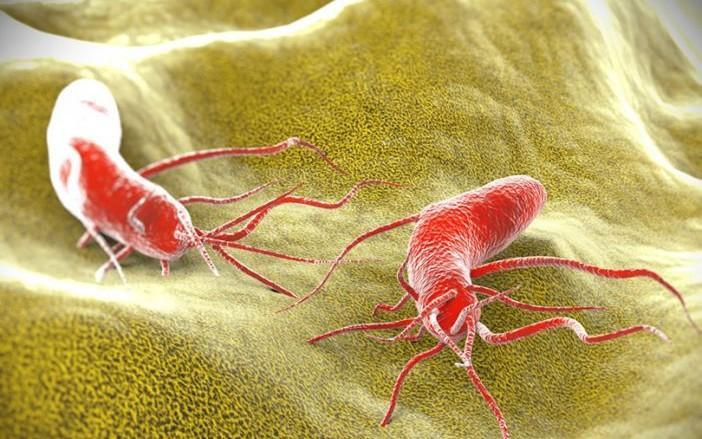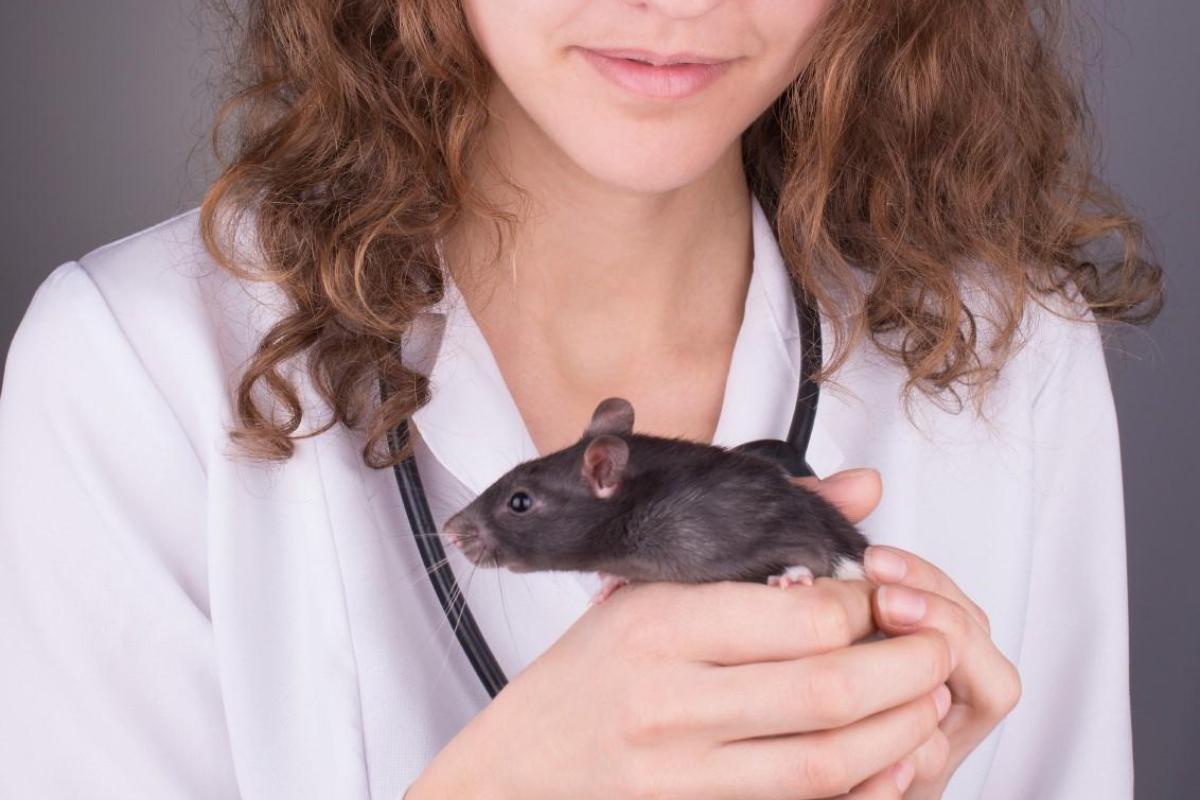Diseases Transmitted by Rats to Humans


Rats do not have the best reputation in relation to disease. One of the worst cases against them was their apparent role in the Black Death which killed potentially hundreds of millions of people in the 14th century. While it is unlikely rats alone were the cause of so much terror, it is important to make certain distinctions when we discuss rat-borne diseases. Perhaps the main distinction we need to make is between wild and domestic rats. The former are animals which can thrive in conditions which humans cannot, leading them to be carriers of various bacteria and disease. The latter are pets much beloved by their guardians and live in relative cleanliness.
Whether wild or domestic, it is important we be careful around rats. While rats self-groom, they can still pick up illnesses from their environment. AnimalWised brings you 10 diseases transmitted by rats to humans, helping us know what to look out for and what to avoid. In doing so, we can keep our adopted rats clean and ensure our own health in the process.
- What diseases are spread by rats to humans?
- Leptospirosis (and Weil's disease)
- Hantavirus
- Tularemia
- Bubonic plague
- Toxoplasmosis
- Salmonelosis
- Rat bite fever
- Typhus
- Internal parasites
- External parasites
What diseases are spread by rats to humans?
As mentioned above, rats can be vectors of various pathogens which can lead to illness in humans. They include viruses, bacteria and protozoa, as well as those spread by internal and external parasites, among others. These microorganisms find their way into the blood, saliva, excretions and even tissue of their hosts, often being eliminated outside the body vie urine or feces.
Although not all, some of these microorganisms carried by rats can be passed on to human beings. If they do, they may be zoonotic. This means they spread disease between the animal and human in the process.
Zoonoses (i.e. zoonotic diseases) can be transmitted from rats to humans either directly or indirectly. If the person has contact with the animal or one of their secretions, they may contract the disease directly. An infected rat can also deposit infected material into food, water, soil or other matter with which a human may come into contact. This results in an indirect transmission. The last common type of transmission is when an insect or ectoparasite which infests the rat transfers to a human. They can then transfer disease, usually through bites and infected saliva.
Next, we will look at some of the most common illnesses transmitted by rats to humans, either directly or indirectly. They are:
- Leptospirosis
- Hantavirus
- Tularemia
- Bubonic plague (black death)
- Toxoplasmosis
- Salmonellosis
- Rat bite fever
- Typhus
- Internal parasites
- External parasites
Before we look at these diseases in more detail, you can learn about zoonoses from other animals with our article detailing the diseases dogs can spread to humans.
1. Leptospirosis (and Weil's disease)
Leptospirosis is a zoonotic disease which has the potential to cause an epidemic. The bacteria which causes the illness is called Leptospira interrogans, something which can affect humans as well as other animals. As with all the diseases on this list, it is imperative for an appropriate diagnosis so effective treatment can be implemented.
The majority of cases in humans present with only mild symptoms. These include fever, headache, myalgia, general malaise and conjunctivitis. In about 10% of diagnoses, serious cases of leptospirosis can lead to the following clinical complications:
- Weil's disease
- Meningitis
- Pulmonary hemorrhage
Weil's disease is simply the term for for an acute and severe form of leptospirosis. This can cause a person to suffer organ failure, seen by jaundiced skin and other symptoms. It is a life-threatening disease spread by rats.
Treatment of leptospirosis is usually based on the administration of specific antibiotics which can kill the Leptospira bacterial infection. It can vary depending on the symptoms, progression of infection and state of health of the individual affected. This is why it is essential to go to the clinic or hospital if you see any abnormal symptoms, especially if you suspect you have received the infection from a rat.

2. Hantavirus
The next zoonotic disease from rats is called the hantavirus (HV). As its name suggests, it is a viral pathology, belonging to the class Bunyaviricetes and the genus Orthohantavirus. It is one of the more difficult zoonotic rat diseases to detect. The main form of infection is through direct contact or inhalation of fecal matter, urine or saliva from the species of rat and mice which can act as vectors for the pathogen[1].
The first symptoms are relatively common to other disease and include:
- Fever
- Muscle pain
- Dizziness
- Chills
- General malaise
- Gastrointestinal disorder
As the hantavirus progresses its infection, respiratory distress and hypotension occur in most cases. These are the first signs of hantavirus cardiopulmonary syndrome (HCPS).
The current figures regarding the distribution of this pathology are alarming. Each year, 300 new cases are detected in the Americas where at least 13 endemic areas have been identified. Most of the cases were diagnosed in rural, agricultural or poorly urbanized environments, although cases in cities have been found. As with leptospirosis, hantavirus is more common in vulnerable communities, especially those with poor sanitation.
The most worrying aspect of this disease transmitted by rats is the fact there is no cure, despite the increases in diagnoses. With about 60% of hantavirus cases being fatal, early detection is key. While no cure is available, treatment of the symptoms can help the body to recover and prevent its further spread. This should ideally be carried out in an intensive care unit. Enforcing hygiene habits in the home and avoiding the accumulation of waste which may attract rats are some of the best methods of prevention.

3. Tularemia
Tularemia is an illness caused by the bacteria Francisella tulariensis which mainly affects wild rodents and small mammals such as rats, rabbits, hares, muskrats and squirrels. It can also be found in domestic pets. Although tularemia in rabbits is the most common manifestation of the pathology, it can also affect cats, dogs, people and domestic rats.
For humans, the main cause of this disease infection is through direct contact with tissue or blood of an infected animal. Eventually, tularemia may also be transmitted by inhalation of contaminated plant matter or soil, as well as bites from fleas, ticks, mosquitos or other insects which act as vectors for the bacteria. Although rare, it is possible for poorly cooked infected meat to spread tularemia to people.
The most frequent symptoms of tularemia in people include:
- Fever
- Chills
- Excessive sweating
- Eye irritation
- Headache
- Muscle pain
- Joint stiffness
- Red spots on skin
- Respiratory difficulty
- Weight loss
Treatment of tularemia in humans is based on antibiotic treatment to both slow down the symptoms and eliminate the bacteria. As always, early diagnosis is incredibly important for the treatment's effectiveness.
In addition to tularemia, you can discover the other diseases rabbits spread to humans with our related guide.
4. Bubonic plague
We continue this list of rat diseases transmitted to humans with bubonic plague, a bacterial zoonosis caused by the Yersinia pestis bacteria. This normally attaches itself to the bodies of small animals and parasites such as fleas. The latter is the main cause of infection in humans, biting the skin of rats before transferring the bacteria through saliva. Rats are one of the most common hosts of fleas. Inhalation or ingestion of affected animal secretions or infected organic matter can also lead to contracting the illness.
During the Middle Ages, Europe experienced the aforementioned Black Death, sometimes referred to simply as ‘The Plague’. While many believe this rat borne-disease is relegated to history, as many as 700 cases a year are still diagnosed across the world. The main areas of concern are the rural and semi-rural landscapes found in Asia, Africa and the United States.
The most common symptom of bubonic plague in humans is inflammation and hypersensitivity of the lymph nodes in the arm, neck and groin areas. The nodes can inflame to the size of a chicken egg and can become both painful and hot to the touch. Additionally, the following symptoms may occur in bubonic plague cases:
- Fever
- Sudden chills
- Headache
- General discomfort
- Muscle pain
In severe cases, the bacteria can reach the bloodstream. If this occurs, septicemic plague can develop. The result is severe abdominal pain, bleeding, extreme weakness, tissue necrosis and, if left untreated, sudden death. Although less frequent, the bacteria can spread to the lungs, causing respiratory problems and bloody coughing.
Plague advances rapidly in the body. When adequate treatment is absent, it can lead to death in only a matter of days. It is essential to seek medical advice if you detect the symptoms of bubonic plague, especially if you have come in contact with rats, rat droppings or similar possible disease vectors. The treatment will be the administration of specific antibiotics, one of the reasons it is so important to seek a specialist and not treat it yourself. Treatment of the symptoms will also be carried out, such as removing dead tissue from necrotic areas.
It is essential we reinforce appropriate hygiene at home, work and anywhere else we spend our time. The accumulation of waste organic matter can attract rodents such as rats and increase the likelihood of spreading illnesses such as the plague.

5. Toxoplasmosis
Toxoplasmosis is a disease which is transmitted by a protozoan called Toxoplasma gondii and can be found worldwide. Transmission can occur through many vectors, although the most common association is with cats. Most commonly, the transmission occurs through the consumption of contaminated food and water.
Felines (domestic cats, pumas, lynxes, etc.) are the main host or reservoir of toxoplasma protozoa. They are also the only animal which eliminate it through their feces. This is something we need to be extra careful with as it is our responsibility to dispose of domestic cat feces from their litterbox. The protozoa collect in cysts in the animal's tissue.
Felines are not the only animals which can carry this cysts of toxoplasma. Sheep, cows, goats and rodents are all possible carriers. When a person consumes raw or uncooked meat from an infected animal, these cysts can activate and start their life cycle again in their new host. Toxoplasmosis can also be passed on from mother to offspring during pregnancy.
The main symptoms of toxoplasmosis in humans are:
- Lymph node swelling
- Headache
- Fever
- Muscle pain
- Sore throat
- Blurry vision
In individuals with low immunity such as pregnant women or people with chronic illness, toxoplasmosis can also cause dizziness, seizures, retinal inflammation and mental confusion. It is imperative that domestic felines receive adequate preventative medicine and have a healthy diet in the form of quality feed. Our article on toxoplasmosis in cats explores more about the risk of this disease for pregnant women and others.
6. Salmonelosis
Another of the diseases transferred by rats to humans is salmonellosis, a well-known infectious disease caused by the bacteria genus Salmonella. The most common infections are due to Salmonella bongori and Salmonella enterica. It is currently one of the most common food-borne pathologies in the world with more than one million people affected annually across the globe.
Salmonella bacteria are naturally present in the intestinal tract of birds and their eggs, as well as in some reptiles. However, the they can survive in organisms of various species, including rodents like wild and domestic rats. Salmonellosis in rats can be transferred from parent to offspring, but many carriers will be asymptomatic. This means they carry the bacteria without any obvious signs of illness.
The main form of salmonellosis transmission to humans occurs orally through the consumption of contaminated food or water, the feces of infected animals or the ingestion of contaminated food such as eggs, raw meat or poorly cooked meat, especially fowl. The bacteria can also enter the body through the ingestion of food which has been cooked, but has also been stored for too long or improperly. Inhalation of the bacteria can also occur.
It is estimated that a large proportion of the world has already come in contact with this bacterium, but most do not develop an infection or they have symptoms which the body can keep under control after a period of about 2 to 7 days. However, salmonellosis will often lead to gastrointestinal problems, manifested mainly through the following symptoms:
- Nausea and vomiting
- Fever
- Chills
- Abdominal cramps
- Diarrhea
- Headache
- Dehydration
- Blood in stool
As with many on our rat-borne diseases list, toxoplasmosis requires antibiotic treatment to fight the pathogenic bacteria. In some cases, analgesics are prescribed to to relieve stomach pain. If the patient is dehydrated, fluid therapy may be required to rehydrate. Other symptoms will need to be treated, perhaps under clinical supervision depending on the vulnerability of the patient and the aggressiveness of the disease.
To prevent salmonella infections, it is important to acquire food (especially eggs and meat) that has passed all relevant hygiene controls. It is ideal to eat in certified restaurants and thoroughly wash fruit and vegetables before eating them. Keeping our hands clean when preparing food and avoiding cross contamination in the kitchen are also vital elements of preventing this type of disease.
If you have rats, other rodents or birds in the home, it is essential to ensure their food is not contaminated. Provide them with adequate preventive medicine and maintain optimal hygiene of their living areas and accessories. We should be particularly careful when giving them human food as we might think it is OK for them, even if it isn't OK for us.

7. Rat bite fever
Another bacterial rat disease transmissible to humans is rat bite fever. Despite its name, it can also be transferred by the bites of other small mammals such as squirrels or weasels. In Europe and the USA, most cases are associated with the bacterium Streptobacillus moniliformis. In Asia, they are more related to the bacterium Spirillum minus and is known as sodoku. These pathogens make their way into the saliva, nasal secretions and urine of the rats.
With Spirillum moniliformis, the bite usually heals relatively quickly. After 3 to 10 days, the following symptoms may appear:
- Fever
- Chills
- Vomiting and nausea
- Diarrhea
- Headache
- Muscle pain
- Skin rash
- Joint inflammation
- Abscesses
- Meningitis
- Pneumonia
- Cardiac inflammation
In the case of sodoku caused by the S. minus bacterium, wounds should start to heal in the first week after the bite. Between 7 and 21 days later, the following symptoms usually appear:
- Fever
- Chills
- Headache
- Muscle pain
- Ulceration
- Red patches
- Lymph node inflammation
- Skin rash
- Haverhill fever
- Vomiting
- Sore throat
- Pneumonia
- Heart infection
- Meningitis
- Hepatitis
In both cases, the treatment will consist of antibiotic administration. The specific strand of Salmonella bacteria will need to be isolated before the right treatment can be issued. The best way to avoid pet rats from contracting the disease is to maintain strict hygiene routines. We also need to ensure wild rats are kept away from our property.
8. Typhus
Typhus is a serious infectious illness which can be caused by two types of bacteria: Rickettsia typhi and Rickettsia prowazekii. It is a disease which rats can transfer to humans that can be best avoided by engaging in proper hygiene routines. At present, two types of typhus are known:
- Endemic typhus: transmitted by both types of typhus bacteria. When caused by R. typhi, it is transmitted to humans by fleas which have previously fed on the blood of rats. In cases of R. prowazekii, lice are the vectors.
- Murine typhus: this is only transmitted by the bacterium R. typhi and its main form of infection occurs through direct contact with feces or bites from infected rats. It can also be associated with other mammals such as raccoons, opossums and cats.
Symptoms of both types of typhus are similar and can present as:
- Abdominal pain
- Back pain
- High fever
- Redness
- Dry cough
- Nausea and vomiting
- Headache
- Joint pain
- Muscle pain
As a bacterial disease, typhus is also treated with the use of specific antibiotics. In more advanced cases, the doctor will need to evaluate whether the administration of oxygen and intravenous fluid therapy is necessary. Again, the best preventive measure is optimal hygiene in the home and adequate pest control.
Learn more about the health of these rodents with our article asking what is the life expectancy of rats?
9. Internal parasites
Internal parasites can severely damage our well-being, brought on as the result of numerous associated health problems. As with most animals, rats can be affected by intestinal parasites such as tapeworms and various protozoa. If we do not take the correct precautions and appropriate measures, these parasites can affect other people and animals which live with affected rodents.
Tapeworms are the main type of internal parasite which can be spread from rats to humans. The main method of transmission is when a human comes in contact with rat feces infested with tapeworm eggs. When infecting the organism of a given human, the tapeworms tend to develop quickly and extensively. They are able to cause nutritional deficiencies, loss of appetite, loss of weight, anemia and even anorexia in acute cases.
Some may not have symptoms, but usually only when the tapeworm's spread is limited. If you do see symptoms, ensure you go to the doctor to be given the right course of antiparasitic treatment. This is likely to be one of a variety of medications which kill the tapeworm in the gastrointestinal system.

10. External parasites
We finish our article on common rat diseases transmitted to humans by talking about ectoparasites, i.e. those which live on the external body of the rat. These may include fleas, mites and ticks. They act as vectors of various diseases as they feed on the blood of the rat and pass it on when they change host to humans. They can also cause allergies, skin problems or scabies, along with many other complications.
When we decide to adopt a rat as a pet, it is essential to avoid the proliferation of internal and external parasites, reinforcing hygiene habits and ensure the pet rat is not exposed to any potential infestations. When we adopt a rat, we will need to take them to the veterinarian to give them an initial examination. Ideally, we will need to speak to a specialist who has experience in rodent veterinary treatment. They will be able to explain the options for deworming a rat as well as providing any necessary vaccinations. 6 month check ups are also ideal to ensure their well-being.

This article is purely informative. AnimalWised does not have the authority to prescribe any veterinary treatment or create a diagnosis. We invite you to take your pet to the veterinarian if they are suffering from any condition or pain.
If you want to read similar articles to Diseases Transmitted by Rats to Humans, we recommend you visit our Prevention category.
1. Pan American Health Organization (PAHO). (2013). Epidemiological Alert, Hantavirus Pulmonary Syndrome (HPS) (17 October 2013).
https://www3.paho.org/hq/dmdocuments/2013/17-October-2013-Hantavirus-Epi-Alert.pdf
- Pan American Health Organization. (2017). Leptospirosis – Factsheet.
https://www.paho.org/hq/index.php?option=com_docman&view=download&category_slug=hoja-informativas-4768&alias=39729-leptospirosis-abril-2017-729&Itemid=270&lang=es - World Health Organization. (2007). WHO guidelines for tularemia.
https://www.cdc.gov/tularemia/resources/whotularemiamanual.pdf - World Health Organization. (2013). Bubonic plague – Fact sheet.
https://www.paho.org/hq/index.php?option=com_content&view=article&id=8933:2013-informacion-general-peste&Itemid=39837&lang=es - Centers for Disease Control and Prevention. (n.d.). Toxoplasmosis – Global health – Division of parasitic diseases.
https://www.cdc.gov/parasites/toxoplasmosis/index.html










